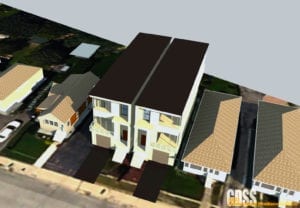As chair has acknowledged (Sept. 29, 2016 meeting), Committee of Adjustment subjectively decides what is Minor, what is Major

Dorothy lives just east of 14 Villa Road, which was the topic of a Nov. 3, 2016 COA hearing. She has lived at her house for 74 years, as she has explained in a brief video entitled: Message from Dorothy, age 97, to the Etobicoke-York Committee of Adjustment, October 2016. Click on the image to enlarge it.
I was at a Committee of Adjustment (COA) at the Etobicoke Civic Centre from 3:00 pm to 9:00 pm on Sept. 29, 2016. Many severances were accepted, some were rejected.
Of all of the COA meetings I’ve attended in 2016, this meeting was a particularly memorable one. I’m pleased to share some highlights from the meeting.
As chair has acknowledged at this meeting, the Etobicoke-York Committee of Adjustment subjectively decides what is Minor, and what is Major. Numbers, as the chair helpfully explained at the Sept. 29, 2016 meeting, have nothing to do with COA decisions.
It may be added that the Official Plan is routinely ignored at COA meetings, and residents are habitually insulted.
A severance application for 101 Government Road in Ward 5 was rejected, at the Sept. 29, 2016 meeting.
The 20 Elton severance was rejected but the 9 Meaford severance was accepted.
The 20 Elton severance was rejected because the committee felt a severance at the location in question was premature. 9 Meaford was accepted because the City of Toronto Planning Department had accepted it. The Committee of Adjustment member, who made the motion to accept the proposal, said that if the City Planner on the file “has no concerns” about the application then it makes sense to go along with the application.
He added that otherwise it would be accepted at OMB anyway, given the Planning Department’s acceptance. During discussions about 9 Meaford, the sense was that the Planner really didn’t have a clear reason for accepting the proposal.
Role of City Planner
Members of the committee emphasized that it’s incumbent upon residents to find out what the City Planner, assigned to a given severance, has to say about an application. In the case of 9 Meaford, the residents made the effort to understand the Planer’s reasoning, but were unable, as I understand, to get a cogent statement from the Planner, indicating what he was thinking when he made his recommendation.
The chair of the committee at one point said, to a Ward 5 or 6 resident who was presenting, that the economics of how developers work is no concern of the committee. Later, quite a bit later, with regard to another severance application, he said that developers have to keep economics in mind when they go about their work. Not much later, a resident of Long Branch had the opportunity to take the floor at the mic and point out the contradiction. The chair indicated that the point was well taken, if I recall.
The chair also pointed out, to many residents who were presenting, that the committee does not deal with water drainage and flooding issues related to severances. That’s for the building department people, not the planners to deal with, he said.
Deferrals
In cases where a deferral had previously been granted, the committee often asked for updates from residents and developers, regarding what had transpired in the period of time subsequent to the deferral. Thats is, had any purpose been served by the deferral?

This is a sample of work by Michael D. Smith. It’s an example of effective 3D modelling in connection with a Committee of Adjustment case near Islington Ave, and Bloor St. West some time back. Click on the image to enlarge it; click again to enlarge it further.
If there had been a plan to set up a community meeting for a given application, the committee typically wanted to know if the meeting had been held, if residents making presentations had been at the meeting, and whether or not any outcomes were evident as a result of the event.
Visualizations
As well, the chair indicated that he would look closely at a professionally prepared visualization of the look of a proposed set of buildings, where it was clear that the metrics of the photo and the drawings were exactly to scale. He indicated that a simple Photoshop overlay would not have much impact. So I would say that, in the circumstances, it makes sense to arrange for suitably sophisticated 3D modelling, with the metrics nailed firmly into place.
If a house on the street is on a City of Toronto heritage properties list, that may carry some weight.
Committee decides what is Minor, what is Major
The committee chair also made it clear that the question of Minor or Major is not based in any way on numbers – the knowledge and judgement of the Committee of Adjustment is what counts, in other words. That is, whether or not something is Minor or Major is, in the circumstances, up to the Committee of Adjustment to decide, as the chair of the Committee noted on a number of occasions.

3D rendering by Mike Smith of Gateway Data and Surveillance Systems, Inc. showing a General Visual Representation of the proposed 14 Villa houses as they would appear at 10:00 am in the month of March. Dorothy’s house is located to the right of the two houses that are proposed in the severance application that was approved by the Committee of Adjustment on Nov. 3, 2016. The decision has been appealed to the Ontario Municipal Board. Click on the image to enlarge it.
Among other things, if I understand correctly, the dictionary definition of words and the standard usage of words, connected with these matters, are nor primary considerations for the Committee of Adjustment, any more than numbers are.
The chair also said, more than once, that residents should push to have the Long Branch Urban Planning Guidelines project completed. He conveyed the sense that the guidelines would in fact help the committee in its future decision making.
As well, the Committee claimed, at the Sept. 29, 2016 that there is nothing in the bylaws that says anything about sunlight or shadows falling on your property, or about whether or not your neighbour can look into your window.
In a future post, I will present a more complete overview of the six hours of hearings, at the Committee of Adjustment, that I attended on Sept. 29, 2016.
This post will serve as a warm-up.

Leave a Reply
Want to join the discussion?Feel free to contribute!